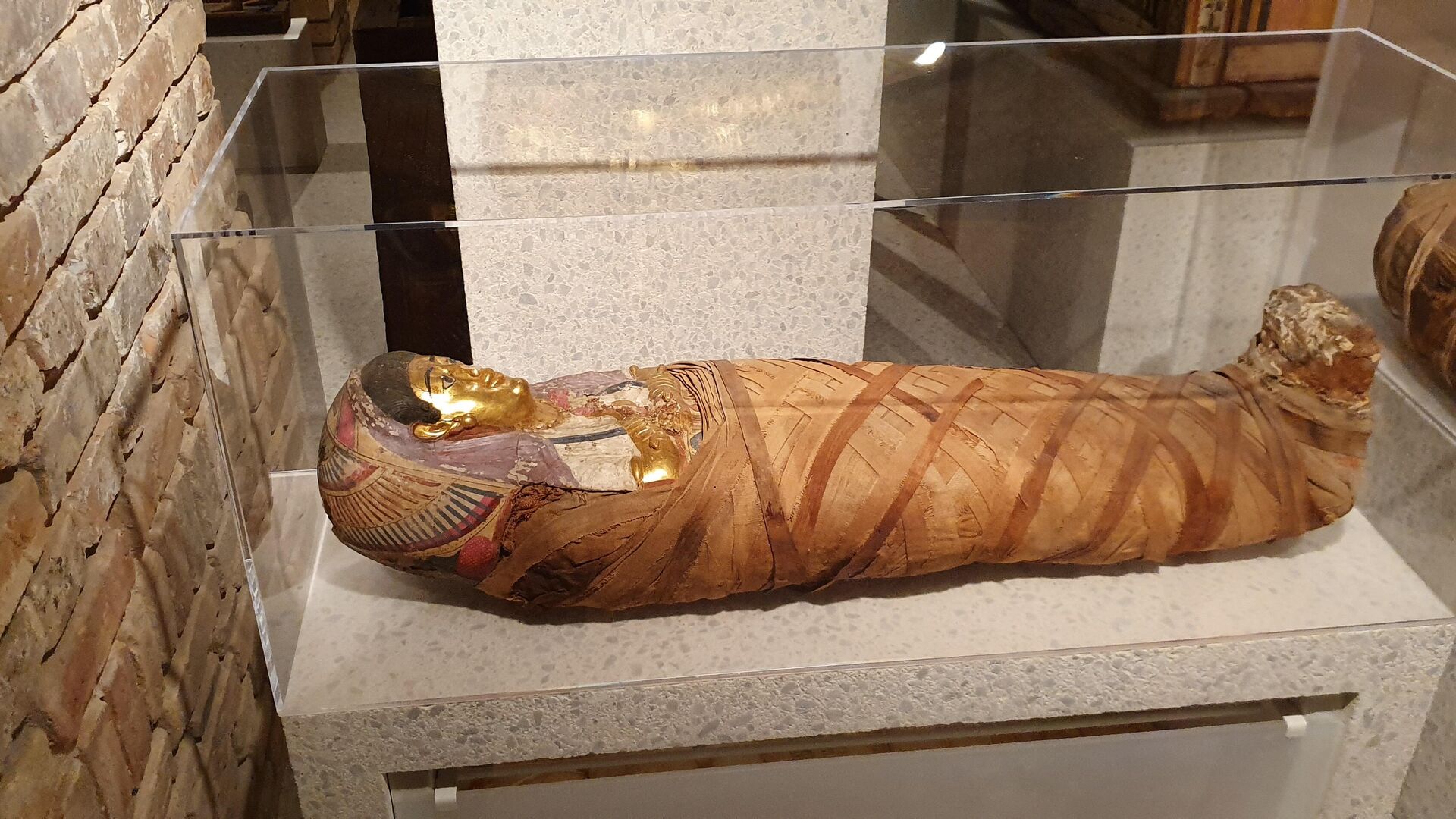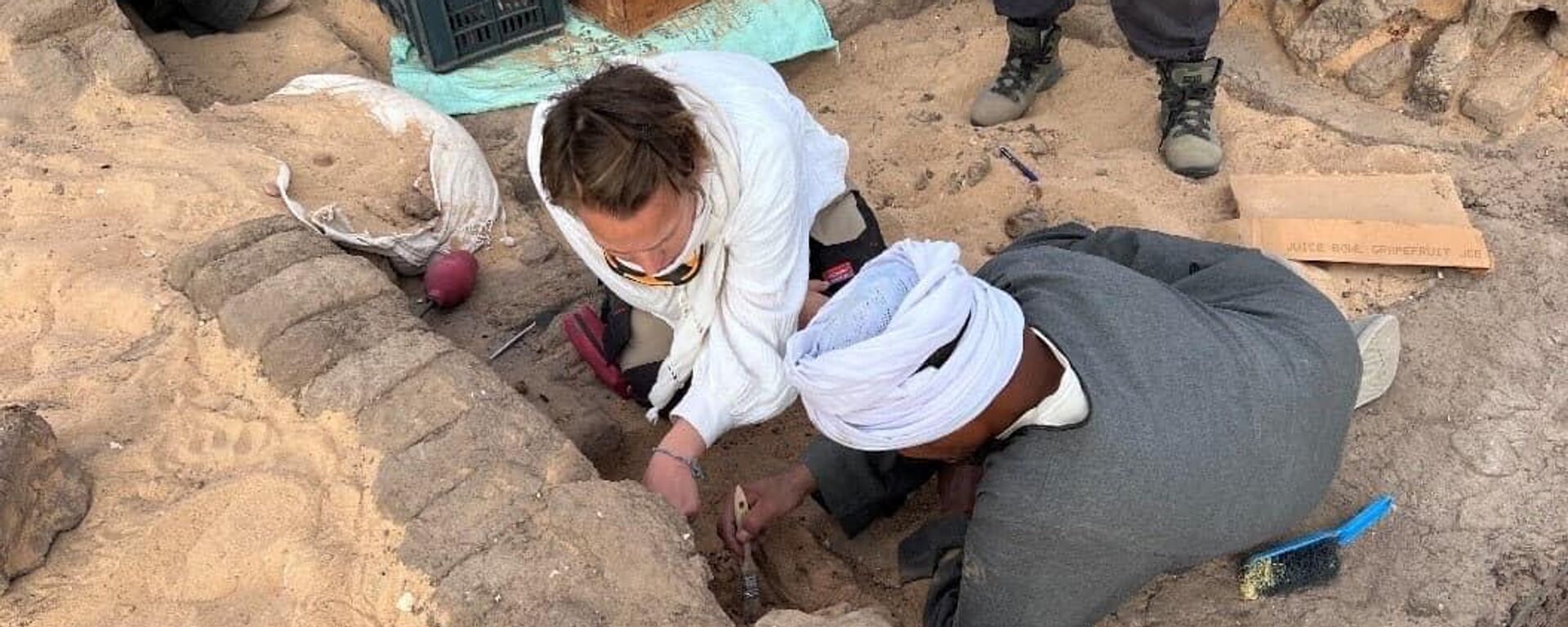https://en.sputniknews.africa/20231023/scent-of-eternity-scientists-recreate-smell-of-mummification-balm-used-in-ancient-egypt-1063025962.html
'Scent of Eternity': Scientists Recreate Smell of Mummification Balm Used in Ancient Egypt
'Scent of Eternity': Scientists Recreate Smell of Mummification Balm Used in Ancient Egypt
Sputnik Africa
Mummification, the process which included embalming the body and organs of the deceased in order to preserve them for afterlife, had been practiced in Ancient... 23.10.2023, Sputnik Africa
2023-10-23T16:56+0200
2023-10-23T16:56+0200
2024-04-25T10:22+0200
ancient egypt
archeology
science
north africa
southeast asia
europe
egypt
history
https://cdn1.img.sputniknews.africa/img/07e7/0a/17/1063028717_320:0:3712:1908_1920x0_80_0_0_72890cf9f1cc267023c6af231965eccd.jpg
A group of German researchers from the country's Max Planck Institute identified the components of the balm used to mummify ancient Egyptian noblewoman Senetnay around 1,450 BC and recreated its scent, a study published in the Scientific Reports journal revealed.The scientists analyzed minuscule residue balm samples from two canopic jars, where Senetnay's lungs and liver were kept, according to the research. Among the balm components that were defined, there were beeswax, plant oils, fats, resins, balsamic substances, and others, the study said.According to the study, the identification of the balm ingredients allows learning more not only about the mummification process but also about the extensive trade relations of Ancient Egypt as it was revealed that along with locally available components, the balm contained those that came from Central Europe, the Mediterranean and the Southeast Asia. As for the Southeast Asia, the research suggested that one particular ingredient presumably originated from the resin of dammar gum tree, which could be found exclusively in this region.In 1900, British archaeologist Howard Carter, who in 1923 discovered Ancient Egypt's pharaoh Tutankhamen's tomb, found Senetnay's remains in the Valley of the Kings, a rocky gorge in Egypt, where tombs were built for the pharaohs, as well as for a number of their high-ranking officials and relatives.Commenting on the study, the lead researcher of the group Barbara Huber explained how "the scent of eternity" was identified.In addition, in order to recreate the scent, at least twenty different formulas were reportedly developed by Huber in cooperation with the French perfumer Carole Calvez. One of the options was selected eventually, which was described as "woody, resinous, balsamic, aldehydic, very warm, and powerful," the outlet noted.Moreover, according to the report, an exhibition at Denmark's Moesgaard Museum, titled "Ancient Egypt - Obsessed with Life" dedicated to ancient Egyptian beliefs in the afterlife, features this fragrance. The head of Moesgaard's Oriental Department Steffen Terp Laursen highlighted that the scent gives visitors the opportunity to travel back in time to 4,000 years ago, the outlet said.As for other significant discoveries connected to Ancient Egyptian civilization, in May, Egyptian archaeologists found the biggest recorded human and animal preservation workshops in the ancient city of Saqqara, south of Cairo, media reported, citing Egyptian Tourism and Antiquities Minister Ahmed Issa.
https://en.sputniknews.africa/20231002/jars-of-5000-year-old-wine-discovered-in-egypt-1062484616.html
ancient egypt
north africa
southeast asia
europe
egypt
Sputnik Africa
feedback@sputniknews.com
+74956456601
MIA „Rossiya Segodnya“
2023
Rasina Musallimova
https://cdn1.img.sputniknews.africa/img/07e7/0a/17/1063019139_0:0:646:646_100x100_80_0_0_348c74b69cf86748a53875f8148a2f85.jpg
Rasina Musallimova
https://cdn1.img.sputniknews.africa/img/07e7/0a/17/1063019139_0:0:646:646_100x100_80_0_0_348c74b69cf86748a53875f8148a2f85.jpg
News
en_EN
Sputnik Africa
feedback@sputniknews.com
+74956456601
MIA „Rossiya Segodnya“
Sputnik Africa
feedback@sputniknews.com
+74956456601
MIA „Rossiya Segodnya“
Rasina Musallimova
https://cdn1.img.sputniknews.africa/img/07e7/0a/17/1063019139_0:0:646:646_100x100_80_0_0_348c74b69cf86748a53875f8148a2f85.jpg
ancient egypt, archeology, science, north africa, southeast asia, europe, egypt, history
ancient egypt, archeology, science, north africa, southeast asia, europe, egypt, history
'Scent of Eternity': Scientists Recreate Smell of Mummification Balm Used in Ancient Egypt
16:56 23.10.2023 (Updated: 10:22 25.04.2024) Mummification, the process which included embalming the body and organs of the deceased in order to preserve them for afterlife, had been practiced in Ancient Egypt for nearly 4,000 years.
A group of German researchers from the country's Max Planck Institute identified the components of the balm used to mummify ancient Egyptian noblewoman Senetnay around 1,450 BC and recreated its scent, a
study published in the Scientific Reports journal revealed.
The scientists analyzed minuscule residue balm samples from two canopic jars, where Senetnay's lungs and liver were kept, according to the research. Among the balm components that were defined, there were beeswax, plant oils, fats, resins, balsamic substances, and others, the study said.
According to the study, the identification of the balm ingredients allows learning more not only about the mummification process but also about the extensive trade relations of
Ancient Egypt as it was revealed that along with locally available components, the balm contained those that came from Central Europe, the Mediterranean and the Southeast Asia.
As for the Southeast Asia, the research suggested that one particular ingredient presumably originated from the resin of dammar gum tree, which could be found exclusively in this region.
In 1900, British archaeologist Howard Carter, who in 1923 discovered Ancient Egypt's pharaoh Tutankhamen's tomb, found Senetnay's
remains in the Valley of the Kings, a rocky gorge in Egypt, where tombs were built for the pharaohs, as well as for a number of their high-ranking officials and relatives.
Commenting on the study, the lead researcher of the group Barbara Huber explained how "the scent of eternity" was identified.
"We only had tiny remains, tiny traces of the mummification balm, the substance she was covered with for the afterlife. We took samples from these canopic jars and analyzed the mummification balm. Based on its molecular composition, we could identify the ancient scent of eternity or the afterlife," she was quoted by media as saying.
In addition, in order to recreate the scent, at least twenty different formulas were reportedly developed by Huber in cooperation with the French perfumer Carole Calvez. One of the options was selected eventually, which was described as "woody, resinous, balsamic, aldehydic, very warm, and powerful," the outlet noted.
Moreover, according to the report, an exhibition at Denmark's Moesgaard Museum, titled "Ancient Egypt - Obsessed with Life" dedicated to ancient Egyptian beliefs in the afterlife, features this fragrance. The head of Moesgaard's Oriental Department Steffen Terp Laursen highlighted that the scent gives visitors the opportunity to travel
back in time to 4,000 years ago, the outlet said.
As for other significant discoveries connected to Ancient Egyptian civilization, in May, Egyptian archaeologists found the biggest recorded
human and animal preservation workshops in the ancient city of Saqqara, south of Cairo, media reported, citing Egyptian Tourism and Antiquities Minister Ahmed Issa.



